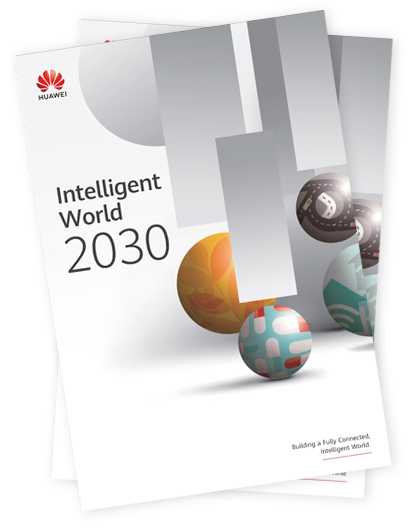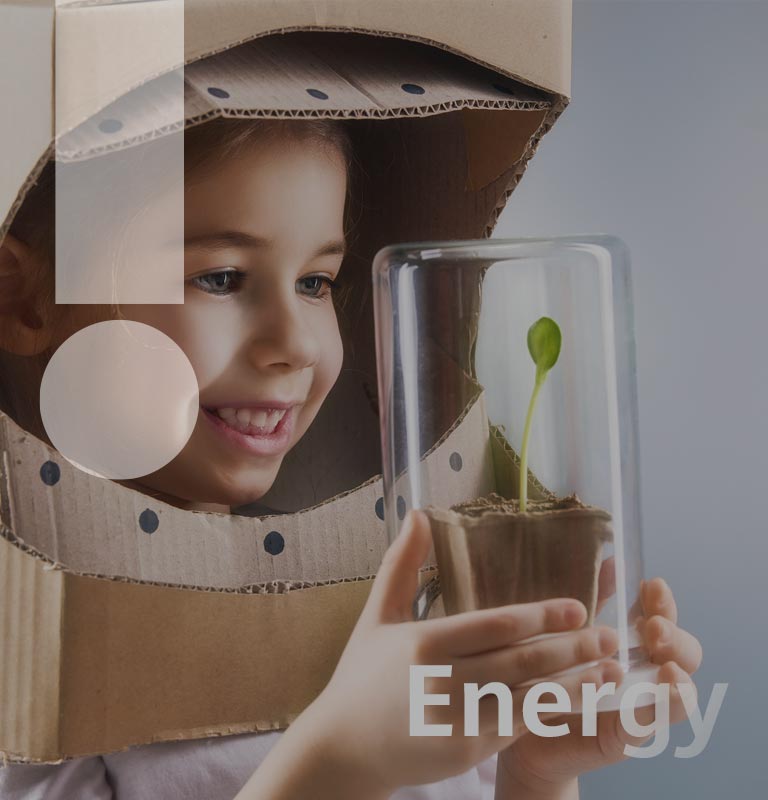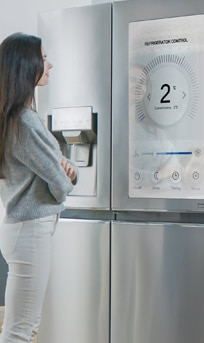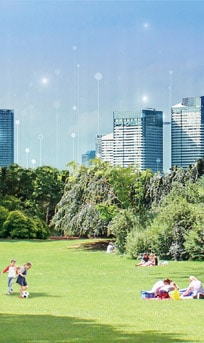Intelligent, Green Energy for a Better Planet
Energy will be greener and more intelligent in 2030. Power plants will be generating electricity from renewable energy sources in lakes and near-shore marine areas. An "energy Internet" will emerge, with digital technologies connecting generation-grid-load-storage, including virtual power plants and an energy cloud. Zero-carbon data centers and zero-carbon telecom towers could possibly become a reality.
Predictions
Directions for Exploration
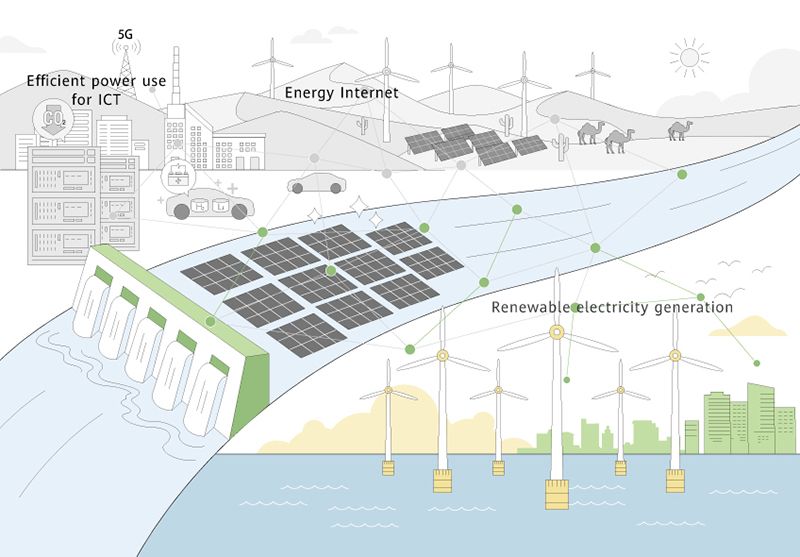
Renewable electricity generation: Floating power plants
Snapshot from the future: Offshore wind and floating PV are promising energy sources for the future
The rapid development of inland wind and solar projects is forcing us to confront problems such as shortage of land, distance from electrical load centers, reduced efficiency of solar photovoltaic (PV) systems under high temperatures, and biodiversity loss. A new trend for the future, particularly apparent in island nations, is building wind and solar power installations offshore to take advantage of the excellent geographical features and abundant space of near-shore locations.
On average, the wind 10 km offshore is 25% faster than wind at the shoreline. Offshore wind turbines can generate power for 3,000 hours a year, compared to 2,000 hours a year for inland counterparts. By 2030, an offshore wind turbine is expected to have an average rotor diameter of 230–250 meters and a capacity of 15–20 MW. The capacity of offshore wind turbines can be 3 to 4 times greater than that of inland wind turbines. Floating turbines can be installed in water up to 60 meters deep. And the new high-voltage direct current (HVDC) technology offers a more cost-effective solution for transmission at a distance of 80–150 kilometers from the coast. The Global Wind Energy Council (GWEC) forecasts that global offshore wind capacity will increase from 29.1 GW today to 234 GW by 2030. Annual installations of offshore wind capacity are expected to grow at 31.5% per year over the next five years.
Compared with land-based PV (LBPV) systems, installation of FPV systems on water saves land for agricultural use. The lack of obstacles on the surface of the water means less shading loss and less dust. In addition, the natural cooling potential of the body of water may enhance PV performance, due to higher wind speeds offshore, along with the presence of water.
A study found that an FPV system performs 12.96% better on average on an annual basis than an LBPV system. The global FPV market capacity will exceed 60 GW by 2030, and the estimated potential capacity is 400 GW worldwide.
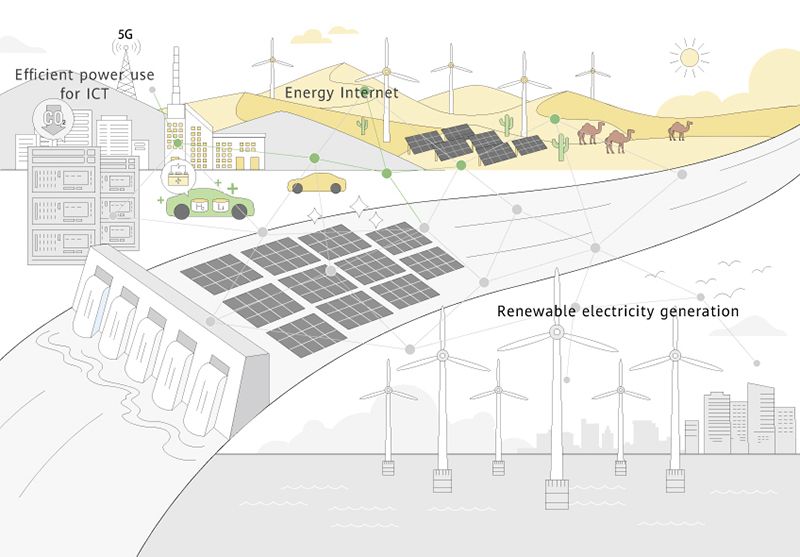
Intelligent generation-grid-load-storage-consumption through the Energy Internet
Snapshot from the future: Virtual power plants, a paradigm shift for the power value chain
The emergence of virtual power plants (VPPs) is redrawing the boundaries between power producers and power consumers. VPPs are set to reshape the power generation value chain.
VPPs will leverage economies of scale to realize the commercial model that distributed energy producers cannot achieve alone. In order to participate in the future energy market and generate profits, distributed energy producers should be able to sense market prices in real time. Distributed new energy devices will need to respond to market changes and power grid fluctuations in real time. This requires ICT infrastructure such as interconnected networks and edge gateways or edge computing. Producers will incur the kinds of transaction costs that come with being part of the market, such as insurance and compliance costs. These additional costs represent a barrier to market entry for distributed energy producers, but by aggregating the large number of distributed energy sources, VPPs reduce costs and generate profits through economies of scale.
Energy cloud can be understood as the operating system of the energy Internet, and is typically characterized by convergence, openness, and intelligence.
Generation, grids, storage, and consumption of power need to be converged in an end-to-end manner. Generators now include a large number of distributed new energy sources, such as solar energy, wind energy, and biomass, as well as fossil fuel sources such as gas.
In addition, the energy cloud needs to interconnect with third-party systems, such as carbon trading systems. Therefore, the energy cloud should be an open ecosystem.
To enable convergence and openness, the energy cloud must be an intelligent platform. With the support of efficient, intelligent technologies such as AI and big data, the energy cloud aims to enable a frictionless flow of energy from producers to consumers as they demand it. Ultimately, it will create a green, low-carbon, safe, stable, and diverse energy system.
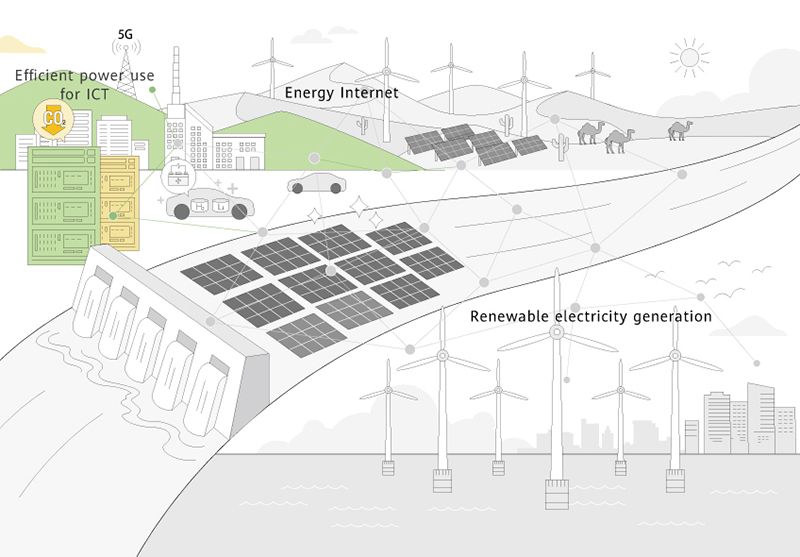
Efficient power use for ICT: Saving energy and cutting more emissions
Snapshot from the future: Low-carbon data centers and sites
The ICT industry needs to achieve carbon neutrality while enabling other industries to reduce carbon emissions. Data centers and telecom networks are the primary sources of carbon emissions in the ICT industry.
Data centers reduce carbon emissions by purchasing green power and applying free cooling and AI. Large ICT companies have been the biggest purchasers of green power, as they strive to reduce carbon emissions in data centers and telecoms networks.
As an increasing number of high-temperature-proof servers are put into use, cooling using natural air instead of traditional chillers and air conditioners will become possible. This will reduce the energy consumption of cooling systems, thereby decreasing the PUE.
In addition to applying renewable energy and free cooling, AI is another effective way to make data centers more efficient and save energy. Sensors in data centers collect data such as temperature, power levels, pump speed, power consumption rate, and settings, which are analyzed using AI. Then, the data center operations and control thresholds are adjusted accordingly, reducing costs and increasing efficiency.
The green telecoms networks of the future will be built to support more than 100 times today's capacity, but their total energy consumption will be no higher than that of today's networks. Conventional telecoms networks are defined by their specialist functions, which makes for fragmented operation and maintenance (O&M) and means they cannot keep pace with the latest network automation and intelligence. Networks need to be reconstructed to deliver essential services through a simplified architecture that consists of three layers: basic telecoms network, cloud network, and algorithms. This simplified network architecture will greatly reduce the complexity of the algorithms in autonomous driving networks, reducing the demand for computing, and cut O&M costs, contributing to greener, low-carbon networks.
More Outlooks
